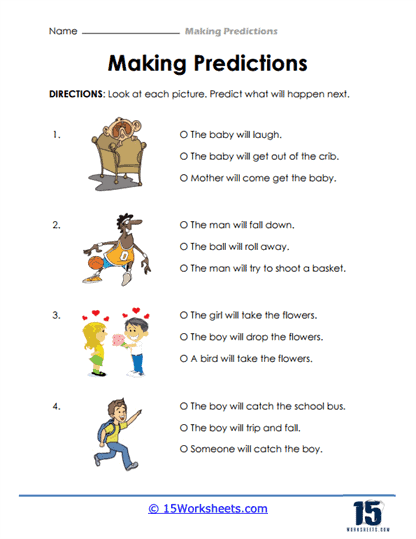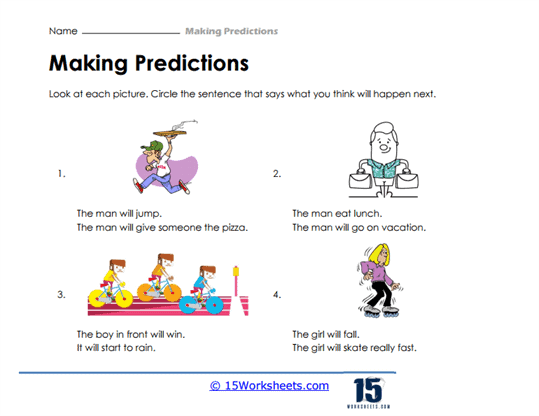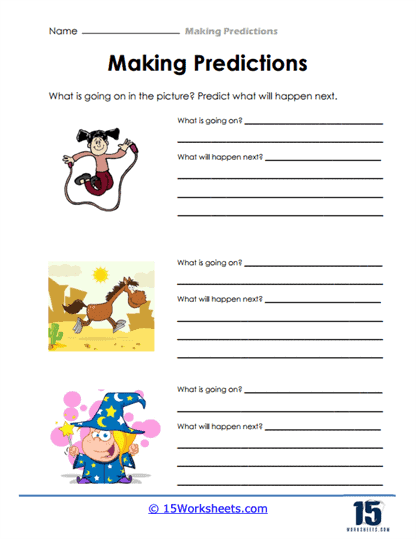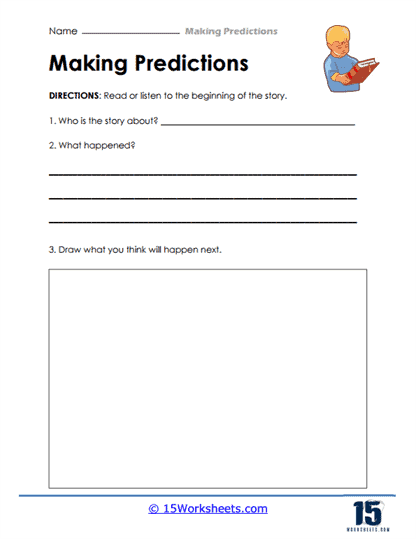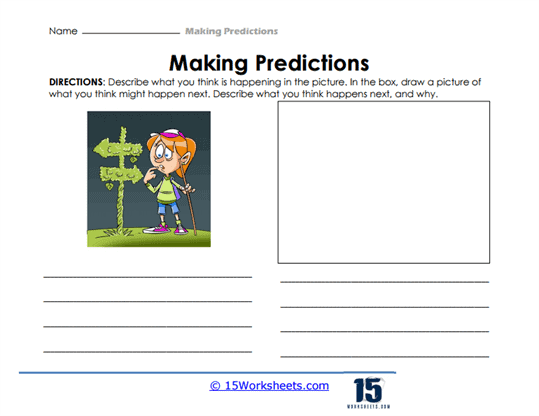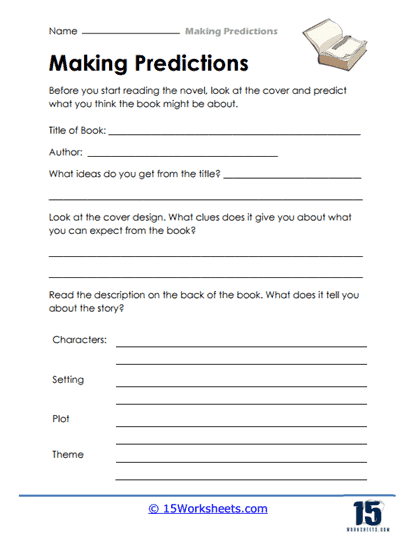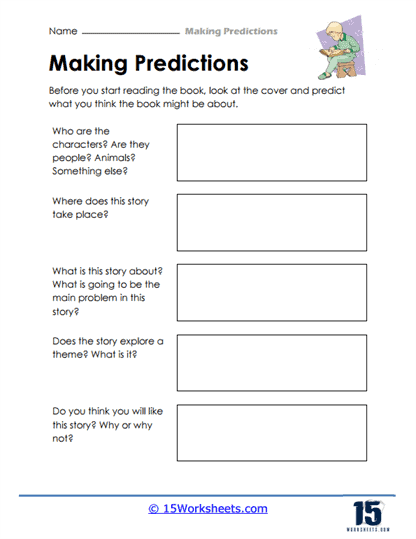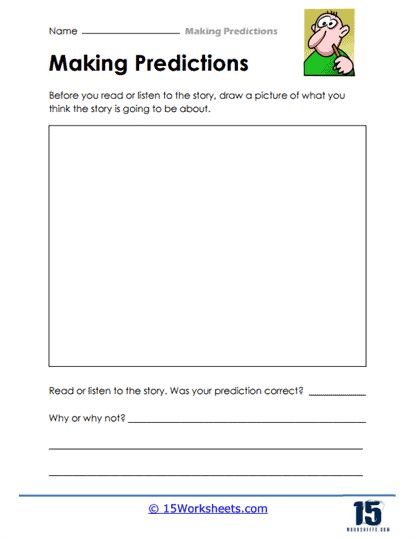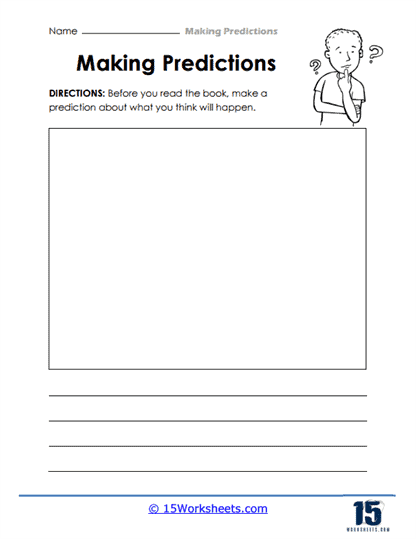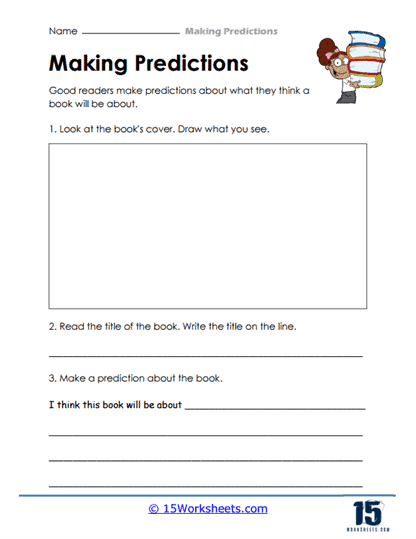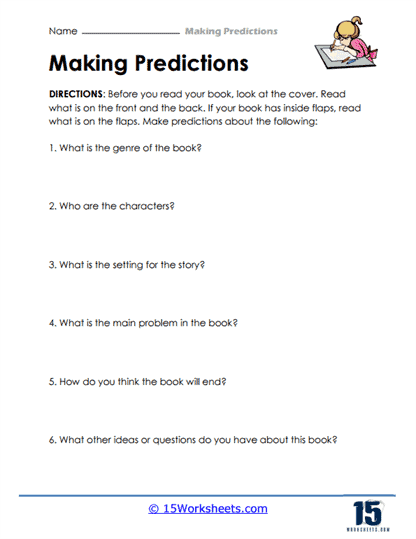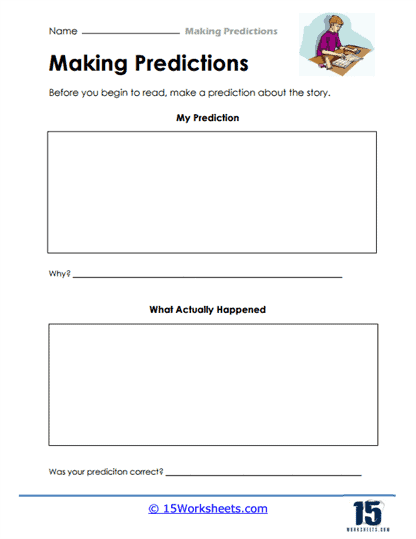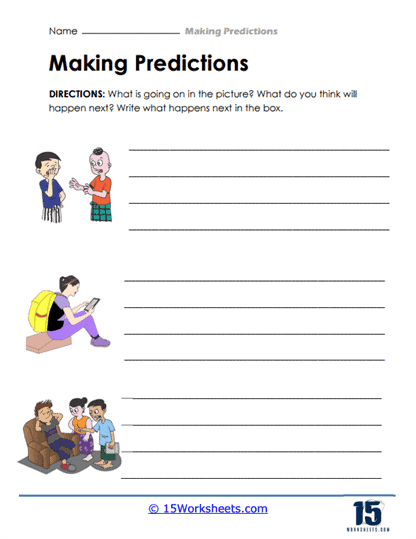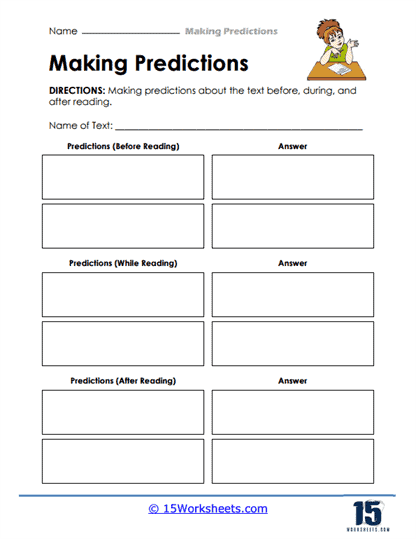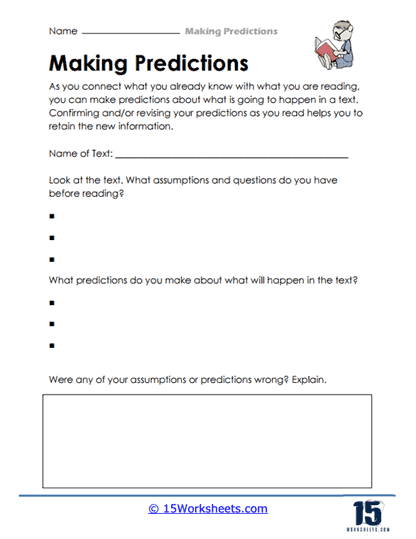Making Predictions Worksheets
All About These 15 Worksheets
Imagine reading a captivating story, an intriguing passage, or even a simple set of facts. Each line you read unfolds something new-a new character, a fresh twist, or an unexpected event. But the story or passage doesn’t just stop there. It invites you into the narrative, asking you not to just passively absorb the information but to actively participate in what comes next. This is where the art of making predictions comes into play.
These worksheets serve as tools that guide you through this process. After reading through the material, you’ll encounter a series of questions. But these aren’t just any questions. They’re designed to spark your imagination and your critical thinking. The questions challenge you to ask: What will happen next? What logical outcomes can be inferred from the events or facts I’ve just read? Predicting outcomes isn’t about random guesses-it’s about analyzing the story, recognizing patterns, and using the clues the author has left behind. In essence, you become a detective, piecing together hints from the text to foresee how the narrative will unfold.
Think about it-how often do you predict what will happen in your day-to-day life? You might predict the outcome of a sports game based on a team’s performance or guess what a friend will say next in a conversation. This same skill is crucial when it comes to reading. Whether it’s a fictional story or a factual passage, making predictions engages your brain in a deeper, more meaningful way. You’re not just skimming words on a page; you’re actively processing them, forming connections, and anticipating possible outcomes.
One of the most significant benefits of practicing predictions is that it strengthens your comprehension skills. When you’re predicting, you’re engaging with the material in real time. You’re asking questions like, “What does this character’s action suggest?” or “Given this fact, what might logically follow?” This mental interaction with the text creates a stronger bond between you and the content, which, in turn, helps you remember and understand it more clearly.
It’s as though your brain shifts from being a passive receiver of information to an active participant in the story. You’re no longer just watching events unfold; you’re predicting the future of the narrative, considering different possibilities, and weighing the evidence that the author has carefully woven into the text. This active reading process not only sharpens your analytical skills but also makes the reading experience far more engaging and enjoyable.
Another important aspect of making predictions is how it encourages you to think beyond the surface level. For example, let’s say you’re reading a mystery novel, and the author subtly describes a character’s nervous glance or a misplaced item. Those details might seem minor, but they’re clues-clues that can lead you to anticipate what might happen next. Will the nervous character confess something important? Does the misplaced item play a critical role later on? By honing in on these details, you start to see how each element of the text contributes to the bigger picture, and you begin to appreciate the complexity of storytelling or information delivery.
But this process of making predictions isn’t limited to fiction. It’s just as essential when reading non-fiction, where facts and events follow a logical sequence. When presented with a series of facts, making predictions allows you to understand how one event might lead to another. This skill is particularly useful when analyzing historical events, scientific discoveries, or current news. Predicting outcomes helps you develop a more nuanced understanding of cause and effect, of how one action can ripple through time and influence the future.
In a broader sense, making predictions also fosters critical thinking. It teaches you to evaluate information thoughtfully, to consider multiple possibilities, and to form educated guesses based on the evidence at hand. This mindset doesn’t just stay confined to reading worksheets-it’s a life skill. The ability to predict outcomes based on current knowledge and context is a valuable tool in decision-making, problem-solving, and even communication.
How Do You Make Predictions When Reading?
When we think about reading, the act may seem passive-just words on a page, sentences to be processed, understood, and stored. But for those who truly want to delve deep into the text, reading is anything but passive. One of the most dynamic and mentally stimulating aspects of reading is the ability to make predictions about what’s going to happen next. This skill, often practiced but rarely named, transforms the reader from a mere observer into an active participant in the narrative.
Making predictions when reading isn’t just a simple guessing game. It involves piecing together clues, drawing upon your own knowledge and experiences, and building a bridge between the present and future of the story. It’s like being a detective, where every word, every phrase, and every detail provides insight into what may unfold. Done well, it enhances not only your comprehension but also your enjoyment of the text. Let’s dive deeper into this concept and explore how to refine this skill step by step.
Step 1: Read with Purpose and Identify Clues
The first step in making predictions is to read with a heightened sense of awareness. You’re no longer passively absorbing information; instead, you’re actively searching for clues. Every text, whether it’s a novel, article, or short story, is sprinkled with hints about what might happen next. But these clues aren’t always glaringly obvious-they require careful attention and critical thinking.
Start by immersing yourself in the details of the text. Pay attention to the setting-where and when does the story take place? Is the atmosphere tense or calm? What does the environment suggest about future events? Next, consider the behavior and emotions of the characters. How do they speak? What do their actions reveal? A character nervously fidgeting might suggest upcoming conflict, while a serene landscape may hint at an impending disruption. Dialogue, too, can be a treasure trove of information. Listen to what characters say, but also what they leave unsaid. A character’s tone or the words they avoid can foreshadow future events.
These are the breadcrumbs the author leaves for the reader, and part of the fun is in spotting them. When you train yourself to identify these clues, you not only anticipate what will happen next, but you also develop a deeper understanding of the story’s structure, pacing, and themes.
Step 2: Draw on Prior Knowledge and Personal Experience
Clues on their own are only half the equation. The next step is to interpret those clues through the lens of your own knowledge and experience. Every reader brings their unique set of life experiences, cultural understanding, and knowledge of the world to the text. This personal lens is what enables you to make informed predictions.
For instance, if you’ve ever experienced stage fright, you’ll likely have empathy for a character who’s described as anxious before a big performance. Based on your own experience, you might predict that this character could falter, make a mistake, or freeze up. Conversely, if you’ve read enough stories where underdogs overcome their nerves to shine, you might anticipate a triumphant moment instead. Both predictions are valid, because they stem from your understanding of human behavior.
The beauty of this step lies in how it makes reading an interactive process. You aren’t just reading about characters or events-you’re using what you know about the world to engage with them. You’re thinking, “If I were in this situation, what might happen next?” or “What does my understanding of this scenario tell me about the possible outcomes?” This active interpretation is what turns reading into a deeply personal and intellectually enriching activity.
Step 3: Test and Refine Your Predictions
Now that you’ve made your predictions, the next step is to continue reading and see how they hold up. This is where the text truly becomes a conversation between the author and the reader. As you progress, you’ll gather more information-perhaps an unexpected twist will challenge your assumptions, or a new piece of dialogue will confirm your earlier predictions.
It’s important to note that making predictions isn’t about always being right. In fact, some of the best reading experiences come from being surprised, from having your expectations subverted. If your prediction turns out to be incorrect, that’s not a failure-it’s an opportunity to refine your understanding of the text. Revising predictions based on new information shows that you’re flexible in your thinking and engaged with the unfolding story. Each time your prediction changes, you’re actively sharpening your comprehension skills.
Authors often deliberately plant red herrings, misleading details designed to throw you off course. When this happens, it forces you to reconsider everything you thought you knew. This process of refining predictions deepens your connection to the text, making every plot twist or character reveal feel like a reward for your engagement.
Step 4: Embrace the Purpose Behind Prediction
At its core, the purpose of making predictions when reading isn’t just to prove yourself right or wrong. It’s about fostering a richer relationship with the material. Predictions challenge you to think critically, to ask questions, and to remain curious about what comes next. This active engagement pulls you deeper into the story, making the experience of reading more immersive and intellectually stimulating.
Even if your predictions aren’t correct, the simple act of making them forces you to stay alert, to pay attention to nuances you might otherwise overlook. You’ll find yourself more attuned to the author’s choices-whether it’s a subtle shift in tone, a repeated motif, or an unexpected word choice. All of these elements combine to create a more textured understanding of the text, one that might elude a passive reader.
The ability to make predictions enhances not just your comprehension, but also your emotional connection to the story. When you invest yourself in anticipating what happens next, you become more involved with the characters and their journeys. You feel their tension, their joy, their fear, because you’re actively thinking ahead about what these emotions might lead to. This emotional engagement can transform a good book into a memorable one, and a memorable book into a beloved classic.

